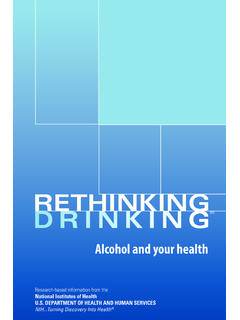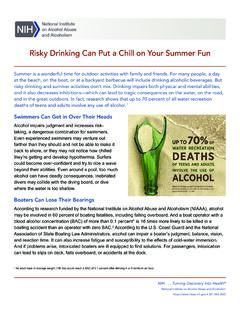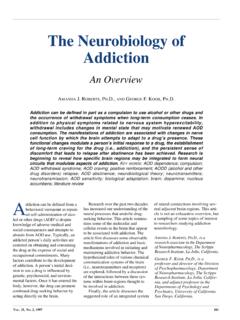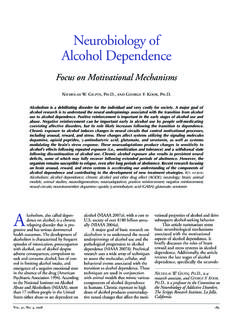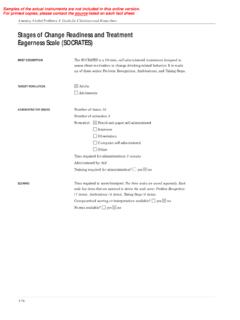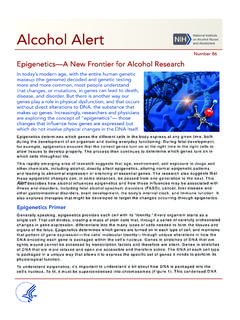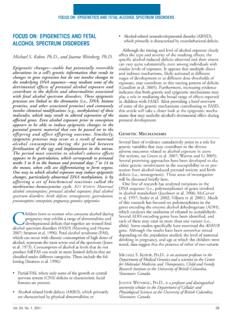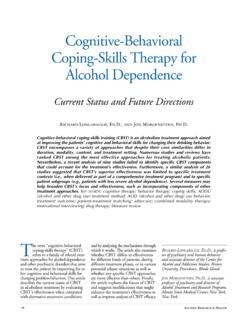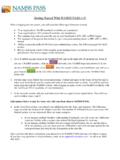Transcription of Alcohol Screening and Brief Intervention for Youth: A ...
1 Alcohol Screening and Brief Intervention for youth: a practitioner's guide 1 in 3 children starts drinking by the end of 8th grade .. and of them, half report having been drunk. Johnston, L. D., O Malley, P. M., Bachman, J. G., & Schulenberg, J. E. (2011). Monitoring the Future national survey results on adolescent drug use: Overview of key findings, 2010. Ann Arbor: Institute for Social Research, The University of Michigan, 77 pp. CONTENTS Introduction .. 1 About This guide .. 3 Before You 5 Alcohol Screening and Brief Intervention for Youth Ages 9 18: Four Steps at a Glance .. 7 For All Patients: Step 1: Ask the Two Screening 8 Step 2: guide Patients Who Do Not Drink .. 9 or Assess Risk in Patients Who Do Drink ..10 For Patients Who Drink: Step 3: Advise and Step 4: At Followup, Continue Appendix Frequently Asked Questions ..14 Clinician Support Additional Resources ..38 1 INTRODUCTION With this guide , the National Institute on Alcohol Abuse and Alcoholism (NIAAA) introduces a simple, quick, empirically derived tool for identifying youth at risk for Alcohol -related problems.
2 If you manage the health and well-being of children and adolescents ages 9 18 years, this guide is for you. It has been produced in collaboration with the American Academy of Pediatrics, clinical researchers, and health practitioners such as yourself. Why choose this tool? It can detect risk early: In contrast to other screens that focus on established Alcohol problems, this early detection tool aims to help you prevent Alcohol -related problems in your patients before they start or address them at an early stage. It s empirically based: The Screening questions and risk scale, developed through primary survey research, are powerful predictors of current and future negative consequences of Alcohol use. It s fast and versatile: The screen consists of just two questions that you can incorporate easily into patient interviews or pre-visit Screening tools across the care spectrum, from annual exams to urgent care. It s the first tool to include friends drinking: The friends question will help you identify patients at earlier stages of Alcohol involvement and target advice to include the important risk factor of friends drinking.
3 Why screen for underage drinking? It s common: Alcohol is by far the drug of choice among youth. It s often the first one tried, and it s used by the most kids (Johnston et al., 2010). Over the course of adolescence, the proportion of kids who drank in the previous year rises tenfold, from 7 percent of 12-year-olds to nearly 70 percent of 18-year-olds (NIAAA, 2011). Dangerous binge drinking is common and increases with age as well: About 1 in 14 eighth graders, 1 in 6 tenth graders, and 1 in 4 twelfth graders report having five or more drinks in a row in the past 2 weeks (Johnston et al., 2011). Chances are, your practice has its share of youth at risk. It s risky: In the short term, adolescent drinking too often results in unintentional injuries and death; suicidality; aggression and victimization; infections and pregnancies from unplanned, unprotected sex; and academic and social problems (Brown et al., 2008). In the long term, drinking in adolescence is associated with increased risk for Alcohol dependence later in life (Hingson et al.)
4 , 2006; Grant & Dawson, 1997). In addition, heavy drinking in adolescence may result in long-lasting functional and structural changes in the brain (Squeglia et al., 2009). | Alcohol Screening and Brief Intervention for Youth | A Practitioner s guide It s a marker for other unhealthy behaviors: When adolescents screen positive for one risky behavior whether drinking, smoking tobacco, using illicit drugs, or having unprotected sex it s generally a good marker for the others (Biglan et al., 2004). For many kids, drinking Alcohol is the first risky behavior tried. So the quick Alcohol screen in this guide can alert you to patients who may need attention for other risky behaviors as well. It often goes undetected: Most adolescents visit a primary care practitioner every year or two (O Connor et al., 1999), and many are willing to discuss Alcohol use when they are assured of confidentiality (Ford et al., 1997). However, the majority of clinicians do not follow professional guidelines to screen all of their adolescent patients for Alcohol use, often citing a lack of confidence in their Alcohol management skills as a barrier (Millstein & Marcell, 2003).
5 To offer support in this area, this guide includes an overview of a promising, teen-friendly approach to promoting positive change in young drinkers (see page 29). As a trusted health care provider, you are in a prime position to identify drinking-related risks and problems in your patients and to intervene. Our hope is that the brevity, ease of use, and predictive strength of this new tool will enable you to detect Alcohol risks and prevent harm at the earliest possible stage. With this guide , you have what you need to begin. 3 ABOUT THIS guide NIAAA created this guide to help you conduct fast, effective Alcohol screens and interventions with your patients, even during Brief , acute care visits. The tools, tips, and resources are designed to help you surmount common obstacles to youth Alcohol Screening in primary care. Typical barriers include insufficient time, unfamiliarity with Screening tools, the need to triage competing problems, and uncertainty about how to manage a positive screen (Van Hook et al.)
6 , 2007). It s about time yours and your patients In primary care, your time is at a premium. Time is also of the essence for your patients who may be considering, experimenting with, using, abusing, or even becoming dependent on Alcohol . With this in mind, we wanted you to have the shortest possible Alcohol Screening tool with the strongest evidence for predicting current or downstream problems in youth. To reach this goal, NIAAA convened a working group of researchers who conducted primary analyses of multiple databases across multiple years. Their extensive analyses boiled down to two questions per patient, varying slightly by age group. Two powerful questions open the door One question is about friends drinking, and the other is about personal drinking frequency (see page 8). The friends drinking question is an early warning signal that strongly predicts the patient s future drinking levels (Brown et al., 2010). It also allows you a nonthreatening side-door entrance to begin talking about Alcohol with younger patients in particular.
7 The personal drinking question zeroes in on frequency, the best predictor of current risk for Alcohol -related harm in adolescents who are already drinking (Chung et al., 2012). The researchers examined many other questions, but these two by far had the greatest practicality and predictive strength. If you re going to ask about Alcohol , these are the questions to ask. (For details about the development of the questions, see page 16 and visit ) The risk estimator can help you triage Acute care visits generally don t allow time for anticipatory guidance. Even during well-care visits, you ll need to choose the guidance to offer. The risk estimator (see page 10 and the Pocket guide ) broadly indicates your patient s chances for having Alcohol -related problems, based on his or her age and drinking frequency. Coupled with what you already know about your patient, it will help you determine the depth and content of your response. 4 | Alcohol Screening and Brief Intervention for Youth | A Practitioner s guide Positive screens become manageable This guide s tools will take much of the mystery out of intervening with your patients who are drinking, allowing you to proceed within a clinical framework of lower, moderate, or highest risk (see page 11).
8 Once you determine that a patient is at lower risk, for example, you ll be able to provide Brief advice, quickly and with confidence, and move on. For patients at moderate or highest risk for Alcohol -related harm, you will have uncovered perhaps the greatest current threat to their health and still, you can manage it efficiently. The guide outlines different levels of Intervention with tips for topics to cover. It also presents an overview of Brief motivational interviewing, an interactive, youth-friendly Intervention considered to have the best potential effectiveness for the adolescent population (see page 29). In addition, the guide aims to help clinicians overcome other common barriers to Screening : concerns about confidentiality (see page 25), a lack of information about coding for counseling about Alcohol use (see page 24), and the challenge of finding adolescent treatment resources for referrals (see page 34). In short, our goal is to support your efforts to protect your patients from Alcohol -related harm.
9 And we want to hear from you. Please send us your comments about this guide and suggestions for ways to improve our support for you by email to 5 BEFORE YOU BEGIN Decide on a Screening method The Screening questions can be used at any time, alone or along with other tools, as part of a clinical interview. Some practices may prefer to incorporate the questions into written self-report questionnaires or computer Screening that patients complete before seeing the clinician. You will need to protect patient privacy, of course, whether you ask the questions in person or by other means. Think about opportunities and clinical indications for Screening As part of an annual examination As part of an acute care visit In the emergency department or urgent care center When seeing patients who: you have not seen in a while are likely to drink, such as youth who smoke cigarettes have conditions associated with increased risk for substance abuse, such as: - depression - ADD/ADHD - anxiety - conduct problems have health problems that might be Alcohol related, such as: - accidents or injury - changes in eating or sleeping patterns - sexually transmitted - gastrointestinal disturbances infections or unintended - chronic pain pregnancy show substantial behavioral changes, such as.
10 - increased oppositional - change of friends behavior - a drop in grade point average - significant mood changes - large number of unexcused - loss of interest in activities school absences 6 | Alcohol Screening and Brief Intervention for Youth | A Practitioner s guide Set up your practice to simplify the process Educate office staff: Ensure that staff members understand the importance of universal Alcohol Screening for youth. Identify a lead champion to establish, monitor, and evaluate office Screening procedures. Decide how Screening will be conducted: If a clinical assistant will screen instead of the physician, or if a print or computerized tool is used, work out record-keeping to facilitate followup in the exam room. Commit to Screening at every possible visit. Set reminders: If available, use electronic medical records to cue for Screening and followup. Prepare for confidential care: Establish procedures for providing confidential care.
